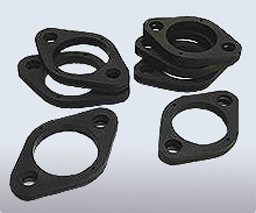
What Is Rubber Molding?
When manufacturers design products and machinery that require intricate pieces, they use the versatile rubber molding process to create them. Clark Rubber & Plastic uses this process to create custom parts for a range of industries. Here’s more information about the molding process and how it works:
Molding Overview
Rubber molding is a manufacturing process that creates custom three-dimensional parts. It involves designing mold cavities into which liquid rubber is injected and set to harden into shape. Rubber molding excels at creating specialty parts with intricate designs that adhere to narrow tolerances. Clark Rubber & Plastic offers rubber part-making services for automotive, appliance, military, solar, and consumer applications.
Molding Process
Rubber part manufacturing begins by creating a mold in the shape of the final part. Some of our clients who use digital design software, including AutoCAD, SolidWorks, and Catia, send us their product specifications to expedite the mold design process.
We offer molding processes that suit multiple applications and production requirements. Compression molding forms parts by placing raw rubber into an open mold to be squeezed into shape. Injection molding involves melting rubber and injecting it into a closed mold to harden. Transfer molding combines these two processes. We use modern injection machinery to produce parts in large capacities, which enables timely production schedules for small and large orders.
After the rubber material hardens in the mold, we inspect the finished part using specialty equipment. Inspection prevents defects and enforces quality control during batch productions.
Molding Materials
The intended use of the finished part informs which materials are chosen for molding. We offer natural and synthetic rubbers, including neoprene, nitrile, EPDM, and SBR. We also offer Viton®, which is a proprietary seal appropriate for gaskets, valves, and pumps. Our staff helps clients select rubber materials based on the needs of their project.
